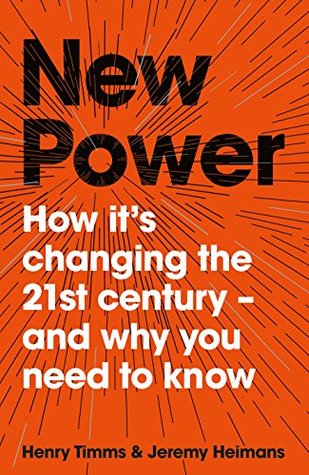More on this book
Community
Kindle Notes & Highlights
Power, as philosopher Bertrand Russell puts it, is the “ability to produce intended effects.”
Like water or electricity, it’s most forceful when it surges. The goal with new power is not to hoard it but to channel it.
No one was the boss of this movement, and no one quite knew where it would go next.
Every individual story was strengthened by the surge of the much larger current.
they figured out how to use today’s tools to channel an increasing thirst to participate.
New power models are enabled by the activity of the crowd—without whom these models are just empty vessels. In contrast, old power models are enabled by what people or organizations own, know, or control that nobody else does—once old power models lose that, they lose their advantage.
The future will be a battle over mobilization. The everyday people, leaders, and organizations who flourish will be those best able to channel the participatory energy of those around them—for the good, for the bad, and for the trivial.
The Ice Bucket Challenge worked not because it was a perfect piece of content, like Nike’s “Just Do It” slogan, but because it created a compelling context to seed activity by people all around the world.
Simple—simplicity is the key Unexpected—surprises you and makes you want to know more Concrete—creates a clear mental picture for people Credible—uses statistics, expert endorsements, etc. Emotional—appeals to deep human instincts Stories—takes you on a journey that helps you see how an existing problem might change The last S doesn’t stand for anything, but they leave it in anyhow, on the basis that SUCCES is not as sticky an acronym as SUCCESS.
ACE stands for the three design principles key to making an idea spread in a new power world: Actionable—The idea is designed to make you do something—something more than just admire, remember, and consume. It has a call to action at its heart, beginning with sharing, but often going much further. Connected—The idea promotes a peer connection with people you care about or share values with. Connected ideas bring you closer to other people and make you (feel) part of a like-minded community. This sets off a network effect that spreads the idea further. Extensible—The idea can be easily
...more
The initiative gave people what we call permission to promote,
“People actually begin changing behavior when [an] idea gets validated by their community, rarely when it has not.”
Today, the most resonant ideas are not those that get flashed at the highest number of people but those that become individualized expressions of affiliation and identity among peers.
it’s only really a movement if it moves without you.
The future will be won by those who can spread their ideas better, faster, and more durably.
movements are proliferating and going “mainstream.” Having a connected and passionate crowd on your side has become a crucial asset,
For any new power movement, identifying and cultivating the right connected connectors is often the difference between takeoff and fizzle.
one of the key signs that you have launched a successful movement is that it starts moving without you.
right recipe for building an effective group is making people feel like they are part of it and that they can stand out in it.
unbranding,” reducing the old power instinct to overwhelm campaigns or ideas with stamps of ownership, and by doing so allowing them to travel more widely.
and central to it was using an existing behavior (the missed call, which everyone was already doing) and by making the barrier to participation low. Taking part was truly frictionless.
Today’s most cutting-edge activists understand both how to create frictionless entry points and move people up the participation scale.
Research on crowdfunding shows that deadlines are everything—most funds raised in crowdfunding campaigns are in the final seventy-two hours.
the most effective crowdbuilders will be those who are able to move people up the participation scale, and sustain and nourish a community over the longer term, dealing with the many challenges, compromises, and balancing acts that requires.
Any new power community has three key actors—its participants, its super-participants, and the owner or stewards of the platform.
Well-designed, intangible reward systems can confer huge meaning for the individuals who take part in them.
well-designed feedback mechanisms that track our progress (and that of our friends) and create a drip, drip, drip of dopamine-fueled satisfaction are increasingly central to most modern consumer technology experiences.
Many new power networks simply wouldn’t function without the reputation systems that manage risk and incentivize collaborative behavior within them.
People place a higher value on objects and experiences they are able to shape.
for more than fifteen years even the biggest TED Talks had an audience of just a few hundred.
Like the jeweler Tiffany, which can whisk a billionaire upstairs to a private salon to inspect the rarest diamonds while it welcomes selfie-snapping tourists in its lobby showroom, TED is able to offer a select few access to the very top of the market and a little something for everyone else.
Placards can be perfect; policies never are.
Those who master the skills we have laid out in this book will be able to shift between old and new power as situation and strategy demands: to flip from open to closed, to toggle between “movement” and “institution,” to know when to control and when to release control.
In the twenty-first century, managerialism as both ideology and practical reality is under assault. Our cultural heroes are increasingly scrappy disrupters, not corporate managers;


